Coastal erosion in Norfolk and Suffolk 'affecting mental health'
- Published

Storms in March 2018 devastated the coastline at Hemsby
People whose houses are at risk of falling into the sea fear that each new storm will be "the one" to take their home, a campaigner said.
Ian Brennan, chairman of Save Hemsby's Coastline, said residents' fear of coastal erosion in Norfolk had taken "a huge toll on their mental health".
He said currently Hemsby was protected by just "a large sandcastle".
It comes as a new report estimates coastal homes worth £584m could be lost to the sea by 2100 in England.
Mr Brennan said about 1.1 miles (1.9km) of coast was under threat in the village near Great Yarmouth, and more than 90 homes were at risk of going into the sea in the next 25 years if nothing was done.
"People here are very nervous," said the 63-year-old.
"Every time there is a storm, those who live within sight and sound of the sea fear it will be the one which means they lose their home."

This chalet was one of seven in Hemsby that had to be demolished after storms in March 2018
Seven bungalows along The Marrams in the village had to be demolished when sandy cliffs washed away in March 2018 and that had followed "the worst storm surge in 60 years" in December 2013 which destroyed seven homes.
He said Save Hemsby's Coastline was formed 10 years ago and the group was trying to get funding and permission for rock berm sea defences - a line of rocks at the base of the cliff.
"Essentially, all we really have is a large sandcastle protecting us," said Mr Brennan.
"It's sand that's blown up, captured by the marram grass, and that's all there is protecting the front of the village.
"There used to be three rows of marrams and now you're down to the very last one and then you're into the village proper."
'Adaptation is possible'
He said an initial lowest estimate for the cost of a rock berm was given as £5m, but, with costs increasing, he said he feared by the time one was agreed, the price could have multiplied.
Mr Brennan said he did not believe a berm would make Hemsby permanently safe, but added: "It will buy time to allow people to adapt their lives.
"Lots of people say 'why are you bothering, you know you can't stop the sea'.
"But adaptation is possible, and it's about spending and political will."
Meanwhile, along the coast in the Suffolk village of Thorpeness, Lucy Ansbro said she had spent £500,000 protecting her home.
She said her neighbour's mansion, once worth £2m, was demolished in October 2022 as receding cliffs made it unsafe.

The Red House in Thorpeness was demolished at the end of last year
"Owners need to know how quickly change can happen if you live on vulnerable parts of the coast," she said.
"I was aware there was a threat of erosion when I bought this house in 2009 - however, I never dreamed it would be this severe.
"No research I did suggested it would ever happen this quickly."
She added: "The worst-case scenario predicted losing five metres to the sea within 50 years but, in fact, I lost five metres in 2020 alone.
"Houses behind mine, less than 50 metres from the clifftop, have recently sold for close to £1m.
"Nobody is taking this seriously or accepting that communities are at serious risk."

Find BBC News: East of England on Facebook, external, Instagram, external and Twitter, external. If you have a story suggestion email eastofenglandnews@bbc.co.uk, external
Related topics
- Published4 January 2023

- Published31 December 2022

- Published15 April 2022

- Published28 August 2021

- Published27 February 2020
